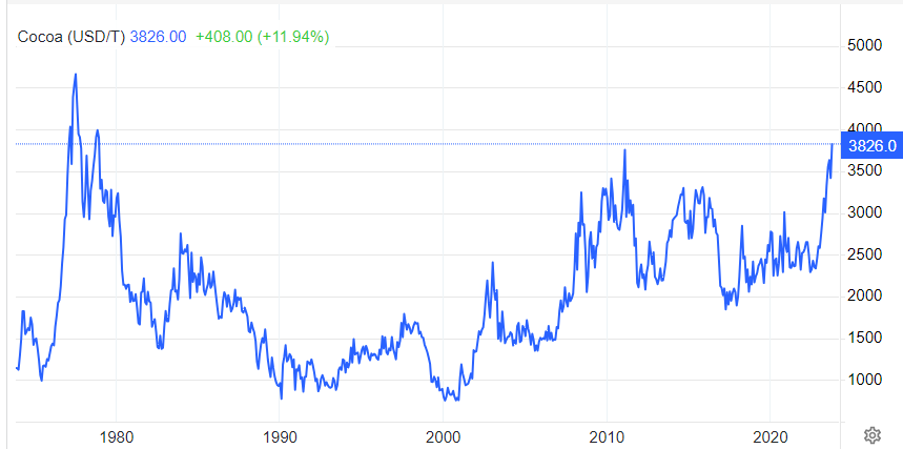-
As most of you will be aware, yesterday was Halloween. Children walk the streets of their neighbourhood dressed as something scary – like a vampire or a ghost or a surprise visitor from the audit office.
They knock on doors and hope their cry of “Trick or Treat” will be rewarded with some kind of lollies or candy. No doubt many of you went shopping for sweet things to keep the kids at bay.
"These figures represent an indication of chocolate demand and show consumers may be reducing their consumption in the midst of other household inflationary concerns.
If you did, you may have been taken aback by the high price of items in the confectionary aisle, particularly any product containing chocolate. Maybe this led to fewer treats than usual for the neighbourhood ghouls.
The background on why prices are so high right now is fascinating and it may help you explain to the disappointed children why their bag is not as full as last year.
The commodity which is seeing the biggest price shock right now is cocoa, the main ingredient of chocolate. Almost half of the world’s cocoa is grown in one country in West Africa – Cote d’Ivoire (or Ivory Coast), with a further 20 per cent grown in neighbouring Ghana.
Heavy rains across these countries have hit the cocoa crops badly. In addition to flooding, the wet weather has also spread black pod disease across cocoa crops, further reducing the supplies.
As a result, 2023-24 is forecast to be the third consecutive year where more cocoa has been consumed than is produced, driving available stocks to very low levels. Global cocoa prices have risen to a 45-year high, at around US$3,800 a tonne, a level not seen since the weather shocks of the 1970s.
GLOBAL COCOA PRICE (BASED ON NYMEX AND ICE PRICE)
{CF_IMAGE}
If you’ve noted the high chocolate prices and bought less as a result, you’re not the only one.
In recent years, demand for chocolate products has been rising globally, particularly in countries with rising incomes and ability to spend on luxuries. However, more recently in the last quarter cocoa bean demand has fallen 12 per cent in the US, 6.5 per cent in Asia and 6 per cent in the European Union.
These figures represent an indication of chocolate demand and show consumers may be reducing their consumption in the midst of other household inflationary concerns. The second factor boosting the cost of sweet things is rising sugar prices.
Sugar high
Globally, sugar prices continue to hover around a 12-year high, impacted by events in the world’s three largest sugar-exporting countries. In Brazil, the relatively high price of oil has seen many sugar producers direct their sugarcane into the production of more profitable ethanol, meaning less sugar is being produced for food and exports.
GLOBAL SUGAR PRICE (BASED ON ICE NO. 11 CONTRACT)
{CF_IMAGE}
India is the number two producer and exporter of sugar. The dry weather has impacted the country’s crops, reducing both production volumes and yields. Faced with a domestic sugar shortage and the potential for Indian sugar producers to boost exports to take advantage of high prices, the Indian government has temporarily banned exports, further lifting global sugar prices.
Similarly, in Thailand, also a major sugar exporter, dry weather has seen production fall strongly. These factors have combined to push sugar prices up – the cost of which is being passed on by manufacturers, to retailers and ultimately to consumers.
But if the cost of chocolates and other confectionery is worrying you and you’re concerned about letting down the children next year – there is some good news.
Recent Australian food inflation figures showed a strong decline in vegetable prices, which have fallen more strongly than any other food category as good weather conditions in many regions resulted in strong crop volumes.
AUSTRALIAN FOOD INFLATION (CHANGE FROM 2022 TO 2023)
{CF_IMAGE}
Given that prices of most vegetables are down – particularly cucumbers and tomatoes, but also capsicums, cauliflowers, avocados and others – perhaps some homes distributed treats which are not only cheaper, but healthier.
Michael Whitehead is Executive Director for Agribusiness Industry Insights, ANZ
The views and opinions expressed in this communication are those of the author and may not necessarily state or reflect those of ANZ.
-
-
-
anzcomau:Bluenotes/Economics,anzcomau:Bluenotes/Commodities
A scary surprise: the price of chocolate
2023-11-01
/content/dam/anzcomau/bluenotes/images/articles/2023/November/nick-fewings-oPVNGh0hzdI-unsplash.jpg
EDITOR'S PICKS
-
Is the cost-of-living crisis even whacking the cost of your morning coffee? From the global cost of coffee beans to paying rent in a groovy neighbourhood – the prices of what brings the Magic to your morning are volatile.
12 July 2023 -
Dairy products such as butter, cheese and yoghurt could get more expensive in coming months, but not for everyone.
4 September 2023



